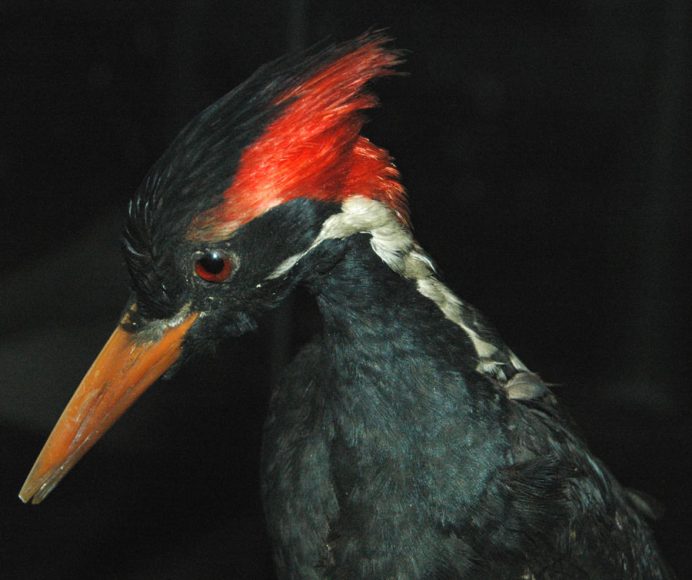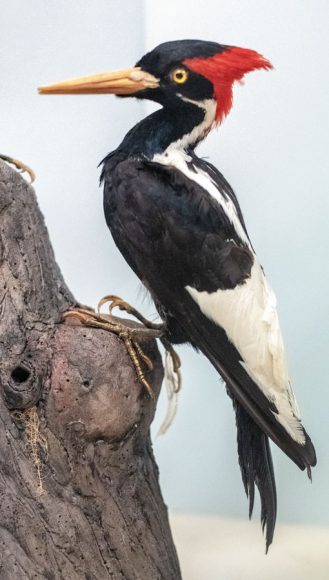In April 1944, a female specimen of the ivory-billed woodpecker was sighted amid the ruins of a decimated old-growth forest in Louisiana. For many ornithologists, this marked the last confirmed identification of a species that was driven to extinction.
Or was it? In the 75 years since that sighting, a contentious zoological debate has percolated over whether the ivory-billed woodpecker is extinct or extant. Some ornithologists and wildlife researchers have insisted they have seen the bird, yet doubters in the scientific and academic worlds argue the lack of conclusive photographic proof has muddied the discussion of the species’ survival.
An unusually large woodpecker — it measures 20 inches with a 30-inch wingspan — the species once
inhabited a range across the southern United States from North Carolina to Texas, reaching as far north as Illinois. Native Americans in the pre-European era hunted the birds for their distinctive ivory-colored beaks, which were worn as symbols of strength in battle. The great avian artist John James Audubon was enraptured by the bird, writing in the early 19th century: “I have always imagined that in the plumage of the beautiful ivory-billed woodpecker, there is something very closely allied to the style of coloring of the great (Anthony van Dyck). The broad extent of its dark glossy body and tail, the large and well-defined white markings and the brilliant yellow of its eye, have never failed to remind me of some of the boldest and noblest productions of that inimitable artist’s pencil.”
The post-Civil War era saw the ivory-billed woodpecker population go into a rapid decline, as logging companies destroyed the old-growth forests that served as their habitat while excessive hunting erased the birds from the air. By the early 1920s, ornithologists declared the bird to be extinct.
However, two nesting woodpeckers were found in Florida in 1924, but a bird-collecting taxidermist fatally shot them. In 1932, another ivory-billed woodpecker was identified after being shot along Louisiana’s Tensas River. Three years later, an expedition from Cornell University and the American Museum of Natural History explored the old-growth forest known as the Singer Tract — named for the property’s owner, the Singer Sewing Co. — and discovered a population of approximately 20 birds, including a nest. This expedition captured the only confirmed film and audio recordings of the ivory-billed woodpecker in the wild.
Efforts to find the bird outside of the Singer Tract were unsuccessful and a campaign was created to preserve the habitat. But the Singer Sewing Co. leased its tract to a lumber company, and pleas from conservationists and Louisiana officials to spare the forest were in vain. The aggressive destruction of the Singer Tract wiped out the only known location for the species.
Yet it seemed the ivory-billed woodpecker did not slip quietly into extinction. Ornithologist and biologist John V. Dennis learned of a sighting in northwestern Florida in 1950, and during his investigation he heard what he believed was the bird’s unique “hant hant” call. Dennis responded to a reported sighting at the Big Thicket area of east Texas in December 1966 and stated he saw the elusive bird for himself. He returned in 1968 and made audio recordings of what he identified as the woodpecker’s call. But the ornithologist community mostly dismissed Dennis’ claims as erroneous and argued the quality of his field recordings were inferior and inconclusive.
In 1971, George Lowery, an ornithologist at Louisiana State University, was given two snapshots taken by a hunter — later identified as Fielding Lewis, Louisiana’s commissioner of boxing — in the state’s Atchafalaya Swamp that appeared to show the ivory-billed woodpecker perched in a tree. Lowery presented the photographs during the annual meeting of the American Ornithologists’ Union, but most conference attendees viewed the photographs as a hoax created by mounting a stuffed specimen in a tree.
Fast-forward to 2004 and the ivory-billed woodpecker was back in the news when Tim Gallagher, the editor-in-chief of the Cornell Laboratory of Ornithology’s Living Bird magazine, claimed to have sighted the bird during an expedition in Arkansas when he was researching his book “The Grail Bird.”
“My sighting with Bobby Harrison (associate professor at Oakwood College in Huntsville, Alabama) in February 2004 gave me a great deal of hope for the species, because their habitat had been at its worst point in the 1950s, after much of the swamp forest across the South had been clear-cut,” Gallagher recalls. “Now the habitat has improved greatly. The fact that we saw one in the 21st century showed that at least a few ivory-bills had made it through that bottleneck and were still breeding.”
Also in pursuit of the ivory-billed woodpecker was Michael D. Collins, a mathematician and acoustics researcher with the U.S. Naval Research Laboratory who embarked on a self-financed eight-year odyssey that produced three videos — two shot on Louisiana’s Pearl River in 2006 and 2008 and another shot in 2007 within Florida’s Choctawhatchee River swamp — showing what he claimed was the supposedly extinct bird. But the imagery in Collins’ videos was blurry and distant, and many ornithologists would not accept his presentations as irrefutable evidence. Some experts suggested Collins repeatedly mistook the similar-looking pileated woodpecker for the elusive ivory-bill, and no ornithology journal would publish his research. In 2017, he published his findings in the open-access journal Heliyon, and he is now working on a book based on his field work.
“These birds are difficult to find and almost impossible to photograph,” Collins laments. “A lot of ornithologists think the bird can be tracked like any other species. The editor of an ornithologist journal said, ‘People get great photos of rare birds all of the time.’ Ornithologists insisting on sticking to a pretty picture, but no one ever obtained a clear photo without knowing the location of a nest.”
Another person in search of the ivory-billed woodpecker is Mark Michaels, a Yorktown Heights-based writer and researcher working on behalf of Project Coyote, a conservation nonprofit. “I believe that I have seen it, but I am more confident that I’ve heard it,” he says. “It sounds like a tin trumpet or clarinet mouthpiece tooting a single note sound.”
Project Coyote is currently working with National Aviary and the Kitzes Lab at the University of Pittsburgh on acoustic monitoring studies in the southern swampland where the bird has been spotted. Gallagher acknowledges that an audio recording could be easier to obtain than a photograph or a video.
“Swamps are a difficult environment for photography,” he says. “You’re usually paddling along in a canoe, trying to weave your way through a tangle of little channels and other obstacles while looking out for cottonmouths and other dangers. If you leave a camcorder running, you pretty much have to set it in wide-angle mode to capture birds flying past on videotape, but then the image is tiny. Of course, if someone can locate a reliable ivory-billed woodpecker roost hole — or even better, a nest — the problem would be solved. Just put a camcorder on a tripod, point it at the hole and leave it running. Or set up a game camera that triggers automatically when something comes into the frame. In our Arkansas searches, we didn’t have a nest or even a roost site for the bird we were seeing, which made finding it very difficult. It was probably a lone bird dispersing up the bayou from somewhere else, perhaps a long way away.”
Just how many ivory-billed woodpeckers might be in the wild is difficult to determine — Collins estimates the population could be around 100, while Michaels believes “the population is increasing gradually over the last 20 to 30 years as its habitat is improving.” But Gallagher believed it was impossible to guess on the survival rate.
“They obviously must be extremely rare or there would be more sightings,” he says.
You might think that capturing live specimens for captive breeding could help save the species, yet Jennifer H. Mattei, professor in the biology department at Sacred Heart University in Fairfield, warned that would be unlikely.
“It would be a mistake at this point,” she says. “Although the endangered California condor was brought back because of captive breeding at San Diego Zoo, these birds are very difficult to breed in captivity.”
Adding to the confusion is another ivory-billed woodpecker based in Cuba, which also popped up after being declared extinct. Whether this is a subspecies of the American bird or a completely different species is uncertain due to the extreme rarity of the Cuban bird.
“The last accepted sighting of a Cuban ivory-bill took place in 1987,” Gallagher says. “I took part in a 2016 expedition in the mountains above Guantanamo in eastern Cuba where the birds were last seen. By the end of it, I did not feel hopeful about the Cuban birds.”
Today, the official status of the ivory-billed woodpecker remains cloudy. The American Birding Association lists the ivory-billed woodpecker as “definitely or probably extinct” but the International Union for Conservation of Nature changed its original listing of “extinct” to “critically endangered.” The U.S. Fish and Wildlife Service places the ivory-billed woodpecker as one of 28 endangered species currently under active review.
“It’s an incredibly strange history of controversy and disputes,” observes Michaels.
Adds Collins, “This is arguably the most elusive bird in the world. There is no other bird like that.” And, Gallagher concludes, “that’s not surprising when you consider that collectors targeted these birds aggressively in the late 19th century. Only the shyest, spookiest ones survived and passed their genes on to the next generation.”







I just saw and took a picture/ video of one yesterday. Crappy quality but none the less cool.
They live here in southern Georgia we have a nesting pair in the pecan tree next to the house. Would post pics but it won’t let me here.